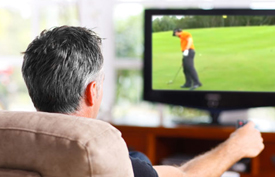There are certain things that almost all sports fans agree upon–college football needs a playoff system; there is no “reality T.V.” like the final minutes of a closely contested game; and some guy sitting on his couch should not be able to influence the outcome of a sport by making a phone call!
The most recent example of a “couch ruling” came from the first event of the PGA Tour season. Camilo Villegas was the victim this time and the Rule was 23-1. During the first round of the Hyundai Tournament of Champions Villegas pitched his ball up the slope on an approach to the 15th green. While his ball was still in motion (rolling back to the area from which he had just played), Villegas moved a few loose impediments. Rule 23-1 states: When a ball is in motion, a loose impediment that might influence the movement of the ball must not be removed.
The point here is not to debate the validity or purpose of this particular rule (if you would like an answer to that question come to our 2-Day Rules seminar at Pinehurst CC on April 2-3!). While most everyone agrees that “couch rulings” have no place in any sport, golf’s unique idiosyncrasies make this a difficult problem to rectify. Unlike most other sports “rulings” in golf are not instantaneous. Many rulings take several minutes to resolve and since most PGA Tour events are contested over four days the competition remains “subject to review” (to use an NFL analogy) not just for a few minutes but for multiple days! This creates a perfect storm that has, and will continue to result in disqualifications like the one this past week with Villegas. When a player leaves the scoring area after a round the scorecard has been officially turned in and the player is responsible for the hole by hole accuracy of that card. If it is discovered before the competition is closed (which won’t be until the final round is over and the trophy presented) that the player has failed to apply a penalty (whether he knew it or not) he will be disqualified for signing an incorrect scorecard.
What is the solution? The Internet is full of helpful suggestions, but if you are expecting a “quick fix” from golf’s governing bodies you might be disappointed. This issue cuts to one of the fundamental tenants of the Rules of Golf and that is that the player is responsible for knowing the Rules and serves as his or her own referee. Villegas should have known better. Not surprisingly, I was unable to find an Internet “post” suggesting that Villegas attend a Rules seminar! Almost all of the proposed solutions were to change the Rules themselves or the way they are applied for televised events.
Whether you like it or not, “couch rulings” will probably continue to be an unfortunate part of our game as long as tournaments are televised. So pass the Doritos and my Decision’s Book and let’s watch some golf!


